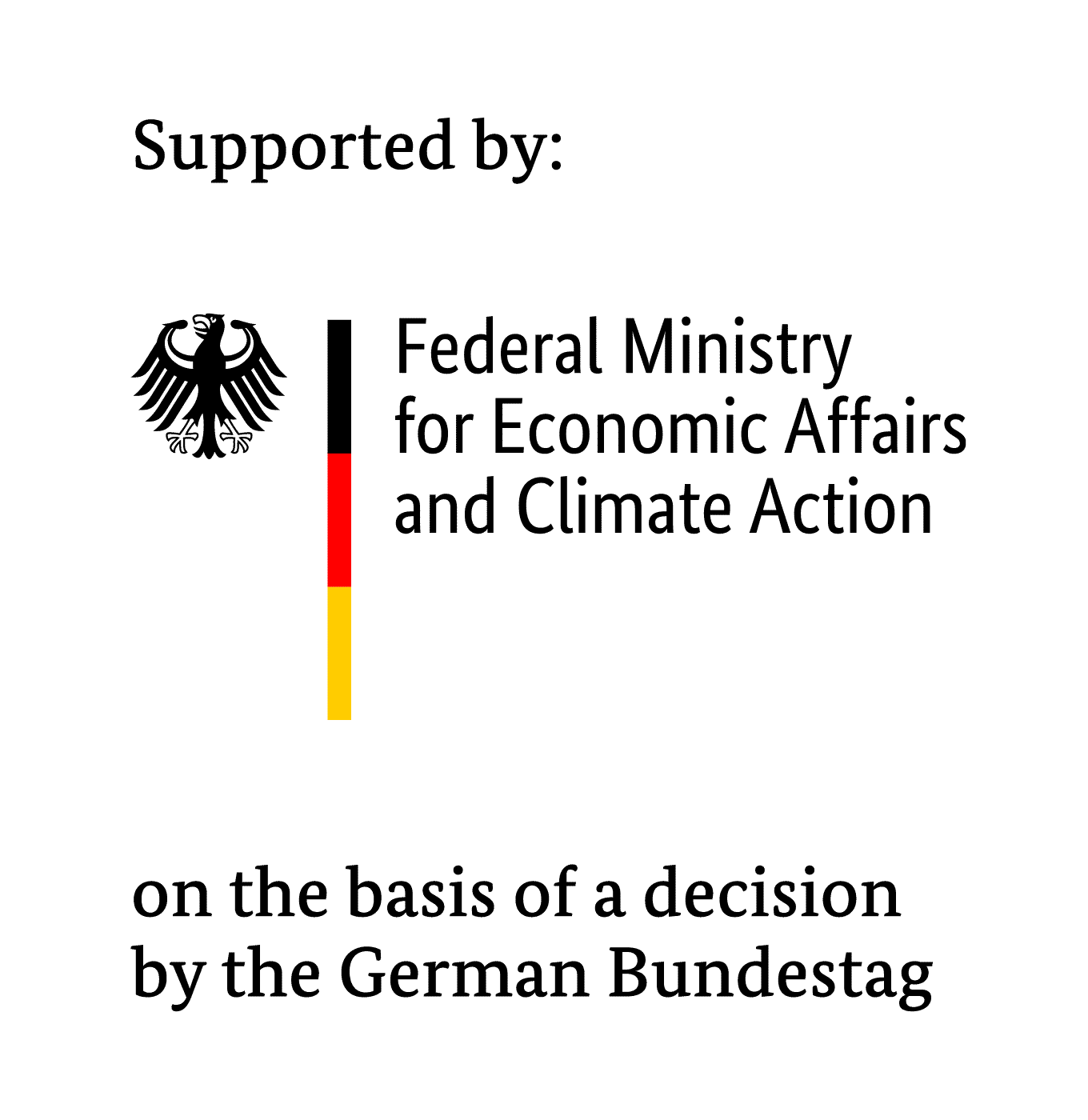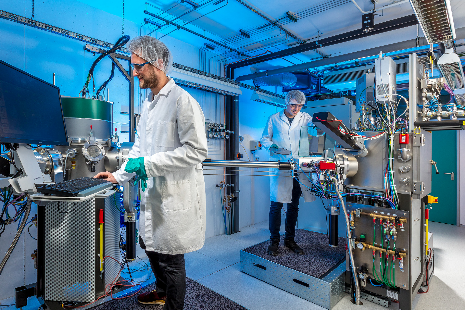
Process engineering, quality assurance and system solutions for thermochromic absorber in solar thermal collectors
The development and application of thermochromic absorbers is intended to reduce the thermal loads in stagnation operation while maintaining collector performance in normal operation.
Overheating protection with thermochromic absorber coating
Thermochromic absorber coatings enable a high collector efficiency in normal operation, but reduce this efficiency when a temperature limit is exceeded so that the collector does not overheat. This happens due to a variable material property of the coating: At low temperature, it behaves like a standard selective absorber: High absorption of solar radiation with simultaneously low heat re-radiation. When the temperature limit is exceeded, the absorber releases excess energy through increased thermal radiation and effectively protects the collector from overheating by a phase change of the material or a special layer structure leading to an increased thermal emissivity.
The ProTASK project bases on the results of the previous project TASK, in which a new thermochromic absorber coating was developed. In the follow-up project ProTASK, the coating system was further optimised, new optical concepts of the coating structure were tested and the process reliability was improved. Parallel to this, the project also focused on research into further, vanadium-free coating materials with “switching” spectral properties. Protective coatings were developed to prevent corrosion and accelerated ageing tests were carried out. Other aspects of the project deal with the solar collector system equipped with the new coating: with the less frequent occurrence of stagnation and the reduced range of the boiling heat transfer medium, and with the associated potential cost savings.
Effective measurement technology is used to achieve the project goals. It starts with in-situ spectral ellipsometry during the coating process in a sputtering facility from DREEBIT, in which variable layer systems are produced with two to three simultaneously operated sources. This allows the optical constants and the layer thicknesses to be precisely controlled at any point in the process. For rapid assessment of the temperature-dependent emissivity, an ε(T) measuring system was set up to determine the emissivity of the heated absorber using a pyrometer. Equally important is a precise optical measurement technique traceable to standards certified by national meterological institutions, which allows the determination of the direct-hemispherical reflectance from 250 nm to 50 µm. Spectral ellipsometry from 240 nm to approx. 33000 nm allows the determination of the spectral refractive index and the extinction coefficient.
The evaluation of thermochromic flat-plate collectors is based on performance measurements on an indoor solar simulator test stand. The performance of thermochromic collectors is investigated experimentally in direct comparison with standard collectors, each with two to four collectors in a typical solar system for domestic hot water heating.
The serviceability of thermochromic collectors is being investigated in several larger solar systems as part of suitable field tests. The aim of the system investigations was to determine new parameters for the design of the solar circuit in order to use less expensive materials due to the lower temperature load. Furthermore, new design rules for dimensioning the systems are determined, which lead to a simplification of the system and a reduction of the specific system costs.
Industry partner:

Duration
01.02.2016 – 30.06.2019
Funding
The project “Process technology, quality assessment and system solutions for thermochromic absorbers in solar thermal collectors (ProTASK)” is funded by the German Federal Ministry of Economic Affairs and Energy based on a decision of the German Federal Parliament (reference numbers 0325858 A and B). The project ProTASK is carried out in cooperation with Viessmann Werke GmbH & Co. KG. The authors are grateful for the financial support.

Publications
C. Xu, F. Heinemeyer, A. Dittrich, C. Bäumer, R. Reineke-Koch: In-situ spectroscopic ellipsometry as a pathway towards achieving VO2 stoichiometry for amorphous vanadium oxide with magnetron sputtering, AIP Advances 11, 035126 (2021), https://doi.org/10.1063/5.0041116
A. Dittrich, F. Heinemeyer, S. Müller, Ch. Xu, R. Reineke-Koch, A. Didelot, N. Portha, C. Leonhardt, B. Hafner: Prozesstechnik, Qualitätssicherung und Systemlösungen für thermochrome Absorber für Solarkollektoren (ProTASK) : Abschlussbericht zum Vorhaben : Kurzbezeichnung: „ProTASK“ : Laufzeit: 01.02.2016-30.06.2019, https://doi.org/10.2314/KXP:1729153925
S. Müller, R. Reineke-Koch, F. Giovannetti, O. Kastner, B. Hafner:
Simulationsstudie zur Leistungsfähigkeit hochselektiver und thermochromer Absorberbeschichtungen für solarthermische Kollektoren. Tagungsband 2. Regenerative Energietechnik Konferenz, Hochschule Nordhausen, pp. 5—72. 2019.
(Der Tagungsband ist erhältlich: https://www.hs-nordhausen.de/forschung/inret/ret-con/ )
F. Heinemeyer, A. Dittrich, C. Xu, S. Müller, R. Reineke-Koch:
Doping of VO2 selective coatings for solar thermal collectors. 16th International Conference on Plasma Surface Engineering, Garmisch-Partenkirchen, Germany, 2018.
C. Xu, A. Dittrich, R. Reineke-Koch:
In-situ spectroscopic ellipsometry applied for thermochromic solar absorber development. European Materials Research Society (EMRS), Warschau, Poland, 2018.
S. Müller, R. Reineke-Koch, F. Giovannetti, B. Hafner:
Experimental investigations on the stagnation behavior of thermochromic flat plate collectors. Proceedings EuroSun 2018, Rapperswil, Switzerland, 2018.
S. Müller, R. Reineke-Koch, F. Giovannetti, B. Hafner:
Experimentelle Untersuchung der Stagnationsbelastungen in einer Trinkwarmwasseranlage mit thermochromen Flachkollektoren. Symposium Thermische Solarenergie, Bad Staffelstein, 2018.
A. Pazidis, R. Reineke-Koch:
Magnetron Sputtered TiOx Layers: Structural, Electrical, Optical and Thermochromic Aspects. Thin Solid Films 649, pp. 43 – 50, 2018. https://doi.org/10.1016/j.tsf.2017.12.019
S. Müller, A. Dittrich, R. Reineke-Koch, F. Giovannetti, B. Hafner:
Thermochrome Absorberbeschichtungen für solarthermische Kollektoren – Stand der Technik, Schichtentwicklung und Systembewertung. Proceedings 1. Regenerative Energietechnik Konferenz, pp. 15 – 26, Hochschule Nordhausen, Germany, 2018.
(Der Tagungsband ist erhältlich: https://www.hs-nordhausen.de/forschung/inret/ret-con/ )
S. Müller, R. Reineke-Koch, F. Giovannetti, B. Hafner:
Flat plate collectors with thermochromic absorber coating under dynamic system tests. Proceedings ISES Solar World Congress 2017, pp. 2062 – 2070, Abu Dhabi. https://doi.org/10.18086/swc.2017.31.10
S. Müller, R. Reineke-Koch, F. Giovannetti, B. Hafner:
Experimentelle Systembewertung von thermochromen Flachkollektoren zur Begrenzung der Stagnationstemperatur in einer Trinkwarmwasseranlage. 27. OTTI Symposium Thermische Solarenergie, Bad Staffelstein, 2017.
A. Pazidis, S. Föste, R. Reineke-Koch, B. Hafner, D. Merc: Entwicklung eines Absorbers für thermische Solarkollektoren mit Stagnationstemperatur unter 140°C und hoher Effizienz : Arbeitstitel: Thermochrome Absorber für solarthermische Kollektoren : Kurzbezeichnung „TASK“ : Abschlussbericht zum Vorhaben : Laufzeit: 01.06.2012-30.09.2015, https://doi.org/10.2314/GBV:870298623
Downloads
- C. Xu, F. Heinemeyer, A. Dittrich, C. Bäumer, R. Reineke-Koch: In-situ spectroscopic ellipsometry as a pathway towards achieving VO2 stoichiometry for amorphous vanadium oxide with magnetron sputtering, AIP Advances 11, 035126 (2021), https://doi.org/10.1063/5.0041116
- A. Dittrich, F. Heinemeyer, S. Müller, Ch. Xu, R. Reineke-Koch, A. Didelot, N. Portha, C. Leonhardt, B. Hafner: Prozesstechnik, Qualitätssicherung und Systemlösungen für thermochrome Absorber für Solarkollektoren (ProTASK) : Abschlussbericht zum Vorhaben : Kurzbezeichnung: „ProTASK“ : Laufzeit: 01.02.2016-30.06.2019, https://doi.org/10.2314/KXP:1729153925
- A. Pazidis, S. Föste, R. Reineke-Koch, B. Hafner, D. Merc: Entwicklung eines Absorbers für thermische Solarkollektoren mit Stagnationstemperatur unter 140°C und hoher Effizienz : Arbeitstitel: Thermochrome Absorber für solarthermische Kollektoren : Kurzbezeichnung „TASK“ : Abschlussbericht zum Vorhaben : Laufzeit: 01.06.2012-30.09.2015, https://doi.org/10.2314/GBV:870298623




